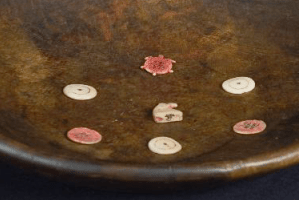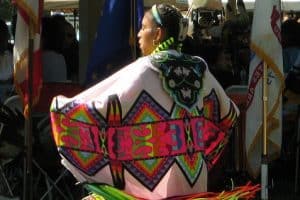MICHIGAN
Kwezage’win: Two-Sided Dice Game
By Students at Hannahville Indian School
Submitted by Richard Sgarlotti
Quinnesec, MI, United States
This two-sided dice game is just one of many played by most tribes in North America. Besides the wooden bowl, dice were contained in baskets or pottery to be shaken. Kwezage’win used dice made from bone, but dice could also be made from other materials:
- peach pits
- flat stones
- acorns
- shells
- carved sticks
This particular game is in the archives of the National Museum of the American Indian in Washington, DC, with pictures and research done by students of the Hannahville Indian School in Michigan.
Kwezage’win
The game was played only by women and mostly in the winter. Like other games, this one is also sponsored by a woman in honor of her guardian spirit, and similar ceremonial preliminaries are held. After the feast, a blanket is spread out on the floor, and the women sit in a circle, but divided into two teams with each side sitting in a semicircle facing the other.
As many women can play as want to, but there are only four prizes — yard goods of red, blue, green, and white. The gaming equipment consists of a wooden bowl and eight dice, six of which are thin, circular discs. One is carved in the form of a turtle and one represents a horse’s head. Dice were formerly made of buffalo rib, but horse’s ribs are used at present.
How to Play
One surface of each die is colored blue (red may also be used). Thus each die has a colored and a white side. The bowl is held with both hands, and the dice shaken to the far side of the bowl which is given one flip, set on the floor, and the score counted.
- all of similar color = eight points
- all of similar color except two = one point
- all of similar color except one = three points
- all of similar color except turtle = five points
- all of similar color except horse = 10 points
- all of similar color except turtle and horse = 10 points
Scoring
The score is tallied by the woman laying out the correct number of bean counters in front of her. Each woman shakes until she misses twice, and passes on the bowl in a clockwise rotation. The first to score 10 points wins the game, and a piece of the yard goods is given to one of the men spectators, who returns a gift of equal value in the future.
Have a suggestion for this story? We’d love for you to submit it!


Blank
Blank
Math Resources
Learning Activity:
Sample Problems:
- What is the probability of all dice coming up red on one flip?
- How does scoring change if you add or eliminate dice?
- Because these are two-sided dice, how might lessons from Pascal’s Triangle be used to construct a more equitable scoring system for the game?
Extension Question
Indian gaming has been around for a long time before the 1989 Indian Gaming Regulatory Act. It was used as a method of distribution of wealth. It is related to the “gift economy,” a mode of exchange where valuables are not sold but given in some way.
- Why do you think gambling was used instead of giving goods away?
- What are the advantages and disadvantages of American Indian gaming today?
Explore Further
- Website of the Hannahville Indian School
- Website of the Hannahville Indian Community
- Website of the National Museum of the American Indian
- Information about a similar dice game
- Other examples of traditional Native American games
- If you can track down a copy, read this article: The Potawatomi Indians of Wisconsin by Robert E. Rizenthaler, Milwaukee Public Museum Bulletin, Vol. 19, No. 3, January 1953.
Share Your Story
Write your own Global Math Story and send it to us!
Sorry, the comment form is closed at this time.